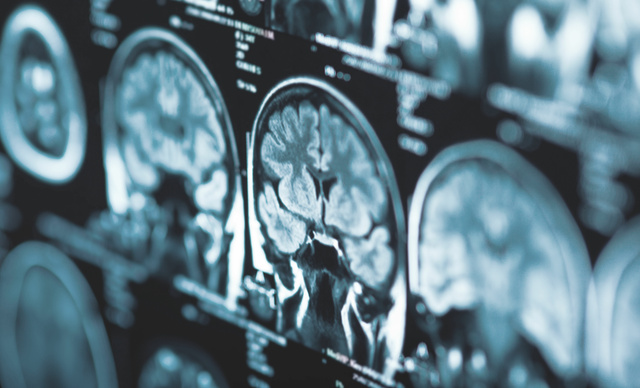Central nervous system and skull base tumors
Tumors of the central nervous system can develop in the intracranial region or in and around the spinal cord. This category encompasses more than 20 distinct tumors. Their prognosis and treatment differ significantly, depending on the type of tumor and patient’s age.

What are primary tumors of the central nervous system and skull base?
Among tumors that develop in the brain and spinal cord, we must first distinguish between primary tumors that initially develop in the central nervous system, and brain metastasis that occurs secondarily among patients who already have cancer in another organ (breast, lung, kidney, melanoma, etc.).
Institut Curie is leading center for these tumors, and has developed multidisciplinary expertise integrating diagnosis and therapeutic treatment.
Primary tumors of the central nervous system in children, adolescents and young adults
These are rare tumors whose classification is rapidly evolving based on anatomopathology and molecular biology. The therapeutic strategy for treatment is personalized, and may include surgery, chemotherapy, targeted therapy, and/or high-precision radiotherapy via X-ray or proton beam.
-
Malignant primary tumors of the central nervous system in adults
- Malignant primary tumors of the central nervous system are mainly represented among adults by glial tumors, both low-grade and high-grade.
- Rare tumors such as medulloblastomas, ependymomas, intracranial germ-cell tumors, and pineal region tumors are most commonly observed among young adults, but can appear at any age.
- Primary cerebral lymphoma is rare. Institut Curie coordinates with AP-HP, the French national expert network for these tumors.
Benign primary tumors of the central nervous system in adults
These tumors develop particularly in the pituitary gland region and include:
- Craniopharyngiomas.
- Pituitary adenomas.
- Meningiomas.
These are treated with complementary approaches to neurosurgery using high-precision radiotherapy technologies, via X-ray or proton beam, that optimize protection of the normal tissues surrounding these benign tumors.
Primary tumors of the skull base
Since they grow in bone, skull base tumors such as chordomas, chondrosarcomas, and osteosarcomas require specific expertise for their local treatment, which is divided between Institut Curie radiotherapists and neurosurgeons. Their removal is difficult and often incomplete, and postoperative radiation therapy is needed. Since they are often resistant, they require a high dose to control the disease, calling for the use of high-precision techniques such as proton therapy, the standard treatment.
What are the warning symptoms?
Symptoms depend on the seat and extent of the lesion:
- In the brain, these cancers can lead to headaches, vomiting, neurological problems such as difficulty walking, motor deficits, etc., and epileptic fits.
- In rarer cases, the red flag is a visual disturbance or endocrine disruption.
- In the spine, the symptoms can be pain, disturbed sensation, and motor disorders.
A physician should be consulted when these symptoms appear, so that a brain scan or brain and/or spinal MRI can be conducted as soon as possible. In most cases, a biopsy is needed to confirm the diagnosis and clarify the tumor’s histological and molecular parameters. Since the tumors are often operated on immediately, the biopsy can be done at the same time. This analysis helps pinpoint the severity of the tumor. These elements are crucial for providing appropriate care.
What is the treatment?
Treatment is multidisciplinary. It depends on the type of tumor, its size, its location, and its age. Surgery plays a decisive role when possible. In most cases, a complementary treatment is prescribed that may include chemotherapy, targeted therapy, and/or high-precision radiotherapy via X-ray or proton beam.
What’s unique about Institut Curie’s care?
Institut Curie’s medical oncologists and radiotherapists work closely with the neurosurgeons. The care they provide is multidisciplinary, to offer patients the most personalized treatment possible from the outset. Diagnosis and decisions are made during cross-disciplinary meetings between pediatric oncologists, medical oncologist neurosurgeons, hematologists, radiotherapists, neuroradiologists, neuropathologists, and biologists. Inter-regional, national or even international consultation is used for patients with complex conditions.
Multiple departments at Institut Curie are involved in treating these tumors: the Medical Imaging department, the Diagnostic and Theranostic Medicine division, the Pediatrics, Adolescent, and Young Adult department, the Medical Oncology department and the Radiotherapy department. Institut Curie has a diverse range of equipment for treating tumors of the central nervous system: intensity-modulated radiotherapy (IMRT), RapidArc, tomotherapy, stereotaxy and proton therapy, which is particularly suited to the treatment of certain tumors among children and adults.
Institut Curie is the leader in molecular characterization of tumors of the central nervous system among adults, children, and adolescents, and focuses on the use of “massive” sequencing techniques that can produce precise diagnoses, working with neuropathologists, and detecting genetic abnormalities that may benefit from a targeted treatment adapted to the biology of each tumor.
An oncogenetic consultation may be recommended for some of these tumors, such as visual pathway gliomas, which can occur within the context of neurofibromatosis type 1 or other tumors of the central nervous system that can occur as part of hereditary cancer syndromes.
Research at Institut Curie
These tumors are the subject of a number of clinical and biological research programs. Molecular phenotyping of tumors is available to guide treatment indications, including potential targeted treatment options in the context of clinical trials, in collaboration with the Clinical Investigation unit.
Clinical trials are underway for tumors in the pituitary gland region and skull base, including chordomas, and interactions with other international proton therapy centers within the Particle Therapy Cooperative Group ensure that patients receive optimal care.

